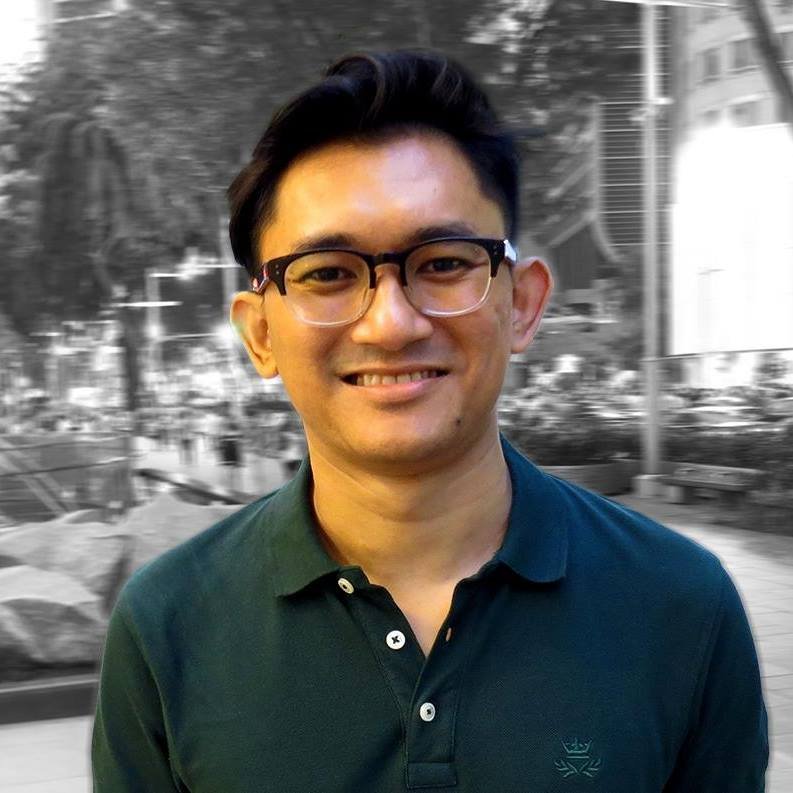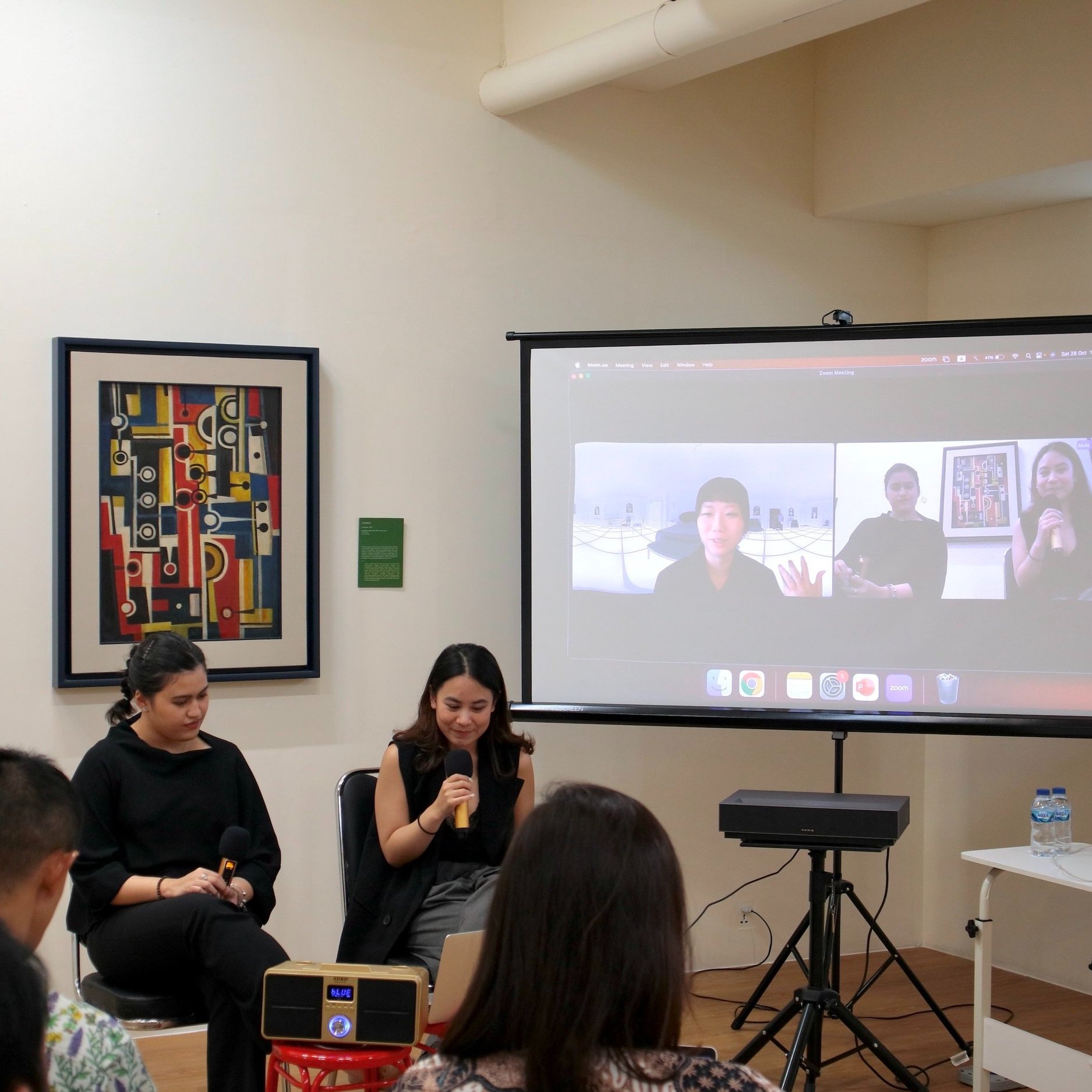My Own Words: Dhaka Art Summit
In Bangladesh, art pleads for LGBTQ acceptance
By Helmi Yusof
'My Own Words' is a monthly series which features personal essays by practitioners in the Southeast Asian art community. They deliberate on their locality's present circumstances, articulating observations and challenges in their respective roles.
It was a sight that I – a Muslim person – had never seen before.
At the Dhaka Art Summit (DAS) in Bangladesh, two groups of Muslim teenagers aged between 12 and 16 were crowding around a large painting by Rasel Rana, as their teachers stood around them. A trained student volunteer, a young man in his 20s, was asking them what they thought of the artwork.
A student volunteer discusses Rasel Rana’s painting with teenage students. Image courtesy of the author.
“The artist is reimagining the Garden of Eden as a place filled with different kinds of people, all living in harmony. Look at them. Look at the figures. Some of them appear genderless. How do you interpret that?” he asked.
The children shouted out possible explanations: “We are all equal in God’s eyes!” “This is before they ate the apple and became male and female!” “It’s just a painting!” “Gender is a construct!” “Transgender people are people too.”
The volunteer liked what he heard and stopped short of offering his own interpretation. He ended it off with: “Well, it’s something to think about, isn’t it? Let’s move on.”
Around the corner, there were paintings by Dipa Mahbuba Yasmin. The artist had painted several portraits of the late SM Sultan, an important figure in Bangladeshi art. Sultan was best known for his pastoral paintings of muscular peasants toiling in the fields.
The portraits of SM Sultan by Dipa Mahbuba Yasmin. Image courtesy of the author.
In Yasmin’s portraits, Sultan was depicted with pink skin and luscious black hair against turquoise and baby blue backgrounds. The walls of this section had been painted pink. Besides these, Yasmin had also painted Mona Lisa as a trans person, as well as the artist Frida Kahlo, who was famously bisexual.
“In his lifetime, SM Sultan avoided being labelled a man or woman. He often wore saris to confuse people. Sometimes he’d put peacock feathers in his hair,” said the volunteer. “As for Leonardo Da Vinci who painted the Mona Lisa, some historians believe that the painting could have been a self-portrait.”
The teenagers took it all in. No one, including the teachers, looked bothered, surprised or offended.
Up ahead, more artworks that pleaded for acceptance and inclusivity.
This time, they were small animal-like sculptures of Mojahid Musa, which were first moulded out of clay, then mixed with other readymade objects such as nails, twigs and buttons. The student volunteer said: “The artist wanted to create unique animals, each with its own individual characteristics. But regardless of how strange and familiar they might look, the artist wants them all to be loved and accepted for what they are. Everything and everyone should be loved equally.”
Finally, the group comes to the photography of Sumi Anjuman, who photographs LGBTQ individuals, often with their faces hidden, sometimes in fantastical outfits, to highlight the themes of persecution, disenfranchisement, hope and survival.
A detail of Sumi Anjuman’s photograph showing a queer couple hiding their faces. Image courtesy of the author.
As a Muslim person born and bred in Asia, I have rarely witnessed first-hand anything close to this kind of compassionate conversation involving Muslim teenagers on LGBTQ matters. In Singapore where I live, the government stopped criminalising gay sex only in 2022. And, for years, school sex education programmes have been subjected to much conservative scrutiny, including well-orchestrated attempts to wrest control over school curriculums through their so-called “family comes first” initiatives – as if LGBTQ people don’t also have families whose love and bonds they need as much as the next person.
“As a Muslim person born and bred in Asia, I have rarely witnessed first-hand anything close to this kind of compassionate conversation involving Muslim teenagers on LGBTQ matters.”
Many in Singapore think that the government had no choice but to remove the anti-gay sex law in 2022. The country’s future voters, the Gen Zs – weaned off TV shows like Glee, Heartstopper and Rupaul’s Drag Race – would likely have no patience for a government that didn’t take steps to address the major social concerns of our time, such as LGBTQ issues, climate change, racial and gender inequities, and mental well-being.
In Bangladesh, a secular Muslim country, there is also widespread discrimination against the LGBTQ community. The infamous Section 377 – the British penal code law that prohibits same-gender intercourse, the very one that Singapore removed in 2022 – is still part of Bangladesh’s penal code, with a maximum punishment of life imprisonment. Just last week, the government had to retract two new school textbooks that tried to address LGBTQ issues.
Yet, in some ways, Bangladesh is ahead of Singapore. For instance, the government has long allowed people to identify themselves as belonging to a “third gender” or “hijras”, which denote individuals who are born male but choose to adopt female identities. The government has given them greater rights in areas such as housing and higher education, while the Islamic clerics have declared them part of the country’s Muslim mainstream.
In spaces such as DAS, art openly pleads with its audience for greater LGBTQ acceptance, through works that brim with empathy and compassion. DAS is a significant arena – the last 2020 edition drew some 500,000 visitors, most of whom were local.
Rajeeb and Nadia Samdani, the wealthy industrialist couple who founded and fund DAS, have also spoken on these issues. Nadia said in an interview with Singapore’s The Business Times: “My daughters have many friends and teachers who identify as LGBTQ individuals. As a family, we feel strongly about promoting diversity, inclusivity, tolerance and acceptance.”
Md Fazla Rabbi Fatiq’s series of photographs on government bridge projects abandoned by corrupt construction companies. Image courtesy of the author.
In fact, all the four works mentioned above were nominated for the inaugural Samdani Art Award 2023 – losing out to Md Fazla Rabbi Fatiq’s gorgeous photographic series on abandoned bridge projects across the country, which highlight systemic corruption behind many construction projects.
On the third floor of DAS, there was a marketplace with various social enterprises and collectives selling “purposeful goods”. One of them, TransEnd, sold books, necklaces, trinkets and other objects to raise money for the marginalised hijra community. The booth was run by hijras as well as student volunteers who identified as straight – and was easily the most popular among visitors.
A TransEnd booth selling wares in support of the hijra (third gender) community. Image courtesy of the author.
To be sure, art dealing with LGBTQ issues was just a small portion of the displayed works by over 160 artists, architects, researchers and designers. Chief curator Diana Campbell wanted a show that addressed “multiple crises” of our time, from climate change to social justice, while at the same time “facilitating hope” for redress and solutions. (To read a broader overview of the event, see my article published in The Business Times linked below.)
These included works that addressed the protracted Rohingya crisis, where close to 1 million Rohingya refugees live in the world’s largest refugee settlement in Bangladesh. These refugees had fled to Bangladesh to escape Myanmar’s brutal genocide in 2017 and now live largely on the Bangladeshi government’s support. At DAS, hand-embroidered tapestries sewn by Rohingya artisans depicting their stories and oral traditions were hung across a few gallery spaces.
Joydeb Roaja’s installation explores the destruction of homes caused by the building of the Kaptai Dam. Photo by Farhad Rahman. Image courtesy of Dhaka Art Summit.
Elsewhere, Bangladesh artist Joydeb Roaja mounted a powerful installation about the indigenous people who lost their homes through flooding caused by the Kaptai Dam construction in 1962; Turkish-born artist Ahmed Ogut staged a protest with performers on bamboo stilts to highlight the scarcity of certain food products in Bangladesh, while Bangladeshi photographer Ashfika Rahman drew attention to the plight of women who suffer from domestic abuse in isolated places.
“Empathy”, “compassion”, “hope”, “openness” and “vulnerability” are words often cited by DAS’ founders and curators. And as one wandered across the four floors of artworks at the Shilpakala Academy, these qualities often came through. DAS has such a big heart that its next edition in 2025 carries the theme of “heartbreak” – the most unpretentious theme for a major art show in recent memory.
I don’t know about you, but I can’t wait to see it. I have a feeling it’ll have a profound effect on me, as this one did.
The views and opinions expressed in this article are the author's own and do not necessarily reflect those of A&M.
For a more comprehensive overview of the Dhaka Art Summit, read “Dhaka’s growing stake in the art world” in The Business Times here.
Read all My Own Words essays here.
About the Writer
Helmi Yusof is the deputy editor of Lifestyle news at The Business Times, Singapore’s top financial publication. He focuses on visual arts, theatre, cinema, books, luxury and travel.




















